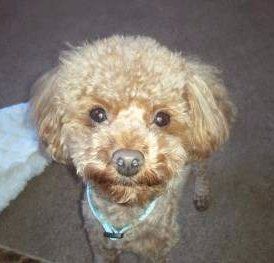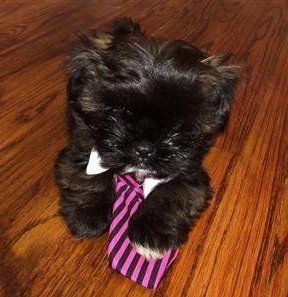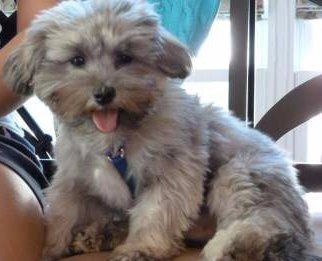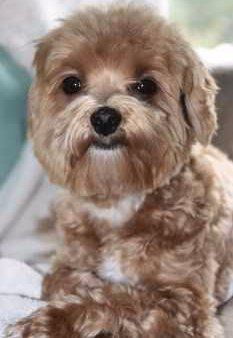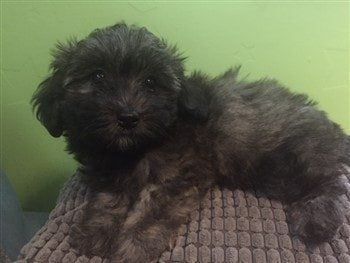Maltipoo Colors
An extremely rare color! This is a Cafe au lait Maltipoo. The liver colored nose and amber eyes sets this coloring apart from a silver beige. Since the white of the Maltese genes normally dilute the coloring of puppies, it is very uncommon to this color on Maltipoo dogs.
Teddy, 4 years old
Photo courtesy of Kathy Riley, Holmen, WI
Overview
The Maltipoo is an exceptionally adorable hybrid dog, that is the result of a Poodle (most often the toy Poodle) and the Maltese. And this is known as first generations. Both the Poodle and the Maltese will have influence on the coat color. As the popularity of this designer dog has taken off and more and more breeders are focusing on the Maltipoo, more are being born as 2nd generation or 3rd generations dogs, which means that coat color is becoming more standardized. Eventually, one day when this breed is accepted by the AKC, he will have a list of accepted colors.
Since the Maltese is a pure white dog, it is the Poodle that will bring color in the coat of the Maltipoo. And though the white will 'wash out' some coloring with the majority of Maltipoos, this still gives us quite an exceptional rainbow of possible coat colors. Once in a while you will even find a Maltipoo with a strong color such as black or red.
Every color that can be found with the Poodle can also be found with the Maltipoo. This includes solids, partis (more than one color) and even some interesting phantom markings.
Dark Coats
With white always at play affecting coat color, you would think that every coat would be somewhat diluted, however this is not always the case. Once in a while, you will find a brown, red or black Maltipoo (one that retains a dark color).
How can this be? In most cases, it will take more than 1 breeding process and the dark puppy will not be a 50/50 blend of breeds. It is a longer process of purposefully breeding
for that color. A purebred black Poodle will be bred with a Maltese, with the goal of producing a grey....That grey Maltipoo will then be bred with a black Poodle, with the goal of producing a 2nd generation Maltipoo....with grey genes and black genes...and the BB genes will then most often produce black Maltipoo puppies.
Maltipoo Colors can be a solid or parti-coat (two colors) of the following:
- Apricot
- Black
- Blue
- Brown
- Cafe Au lait
- Cream
- Gray
- Red
- Silver
- Silver beige
- White
With parti's (two colors) those colors can be any percent, blends, spots or patches.
Super unique coloring of a black and brown mix.
Pixel Mejia, at 5 months old
Photo courtesy of Chris and Michelle Mejia
Let's Talk About Some of the Wonderful Colors
Black -
A true black Maltipoo is extremely rare. This will be deep ink black. To be labeled a solid black (and not a parti [2 colors], the dog's coat will have no other color. If there is just a touch of coloring (not enough to classify as a 2nd hue), this will be a 'black with a mis-mark'. It is more common to have a black parti that has blue or silver tinting and/or white or silver guard hairs.
A true black
will not have a color change. (This is called a "fade" with the Poodle breed). More about color fading ahead.
Blue -
This is an extremely rare color. It is a diluted black and is often mistaken for black by many people. Blue is based on skin pigmentation, not coat color. If the nose, eye rims and paw pads are blue, the dog will be blue and not black. One often cannot notice this unless the dog is outside in direct sunlight...it is at that time that you would see a hint of blue that shines from the nose leather. In just about every case, a blue Maltipoo will be born black and at the age of approximately 1 to 2 years, the coat will lighten (often called clearing).
Phoebe Louise
Photo courtesy of the Erickson Family
Cafe Au lait
- This is rare with Poodles and therefore with Maltipoos. This is a light, shiny tan and is distinguished from a sliver beige, based on the skin pigmentation. Cafe au lait colored Maltipoos will have a liver nose and dark almond eyes.
Brown
- A brown
is a deep, dark color...much deeper than tan, golden or bronze. Some equate the hue with a soft, melted chocolate bar.. Brown is created by the bb gene, as opposed to the BB gene of black dogs, and therefore will have no black pigment anywhere on the body, including the eyes and nose. Those areas will be brown.
Bronze
- This is becoming a 'standard' coloring for Maltipoos, dogs that do not yet have a breed standard and is an unofficial coloring. When any particular hybrid dog becomes popular, new coloring terminology inevitably begins to pop up, and bronze is one of them...This is a color in the brown spectrum that some people use to describe a shiny, lighter brown....commonly "tan" would be the more simple term to use.
Gorgeous silver gray and white Maltipoo.
Charlie, 4 months old
Photo courtesy of Samantha Jones
Cream
- A nice, soft hue. These dogs will be an off-white color. Some people with very light cream dogs will call their dog "white", however when put side by side with a white dog, there is a clear and distinctive difference. It is the Cch gene which causes an otherwise brown dog to be cream. Some creams have a darker coloring on certain spots, particularly on the ears. This is often tan, apricot or gray.
White
- This is one of the most sought after colors for the Maltipoo. Since a purebred Maltese is already a pure snow white, when bred with a pure white Poodle
(with no color in the genes for at least 5 generations back), the puppies will be pure white.
Gray
- While a Maltipoo can be born gray and stay gray for life, it is also not uncommon for a parti-black Maltipoo to turn gray at the age of 4-5 years old.
Red
- This is a very rare color, since most Maltipoos when bred 50/50 will be of a light shade. This color is even rare for the Poodle and only became an official AKC color for the breed in 1980. Read about red Maltipoo dogs.
Apricot
- You would think it would work the opposite way, but it is an apricot that throws out a red and not the other way around. It is the recessive f gene will decide if the coat falls to apricot or red. Some apricot Maltipoos
are so light that they appear to be cream, however you will notice a red tint to the hair. A solid apricot may have a secondary color and if that color is a deeper and darker tone of apricot, he will be a red.
Silver
- Many times, with a silver, the puppy will be born dark and then lighten as he matures into a shiny silver. One may wonder what the difference is between a grey dog and a silver one...Silver is a diluted grey and is produced by the silver allele V gene. When standing a grey and silver side by side, one would see how the silver is lighter and has more shine to the coat.
Silver Beige
- A very rare color which is a diluted brown. In many cases the puppy will be born brown and a color change will take place at approximately 6-7 weeks...The coat will begin to lighten around the face and paws. By the age of 2 years there will be a full coat changeover to this shiny, unique hue. Dogs of this color have black skin pigmentation; eyes, nose and paw pads.
A silver beige; the difference between this and cafe au lait is that this dog has a black nose (and eye rims, lips and paw pads)
Buddy,Photo courtesy of Gerald Frederick
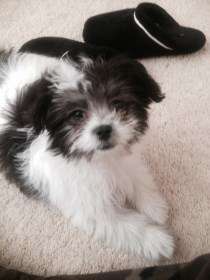
A strikingly beautiful coat of white and black. Panda bear schluentz, PHoto courtesy of melissa
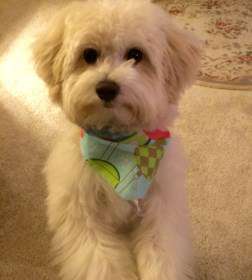
A soft, warm cream
Athos, 23 months old
Photo courtesy of
Anna Liechty
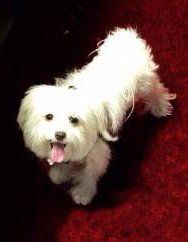
A pure snow white
Bella, 2 years old
Photo courtesy of Dennise (San Francisco Bay Area)
Unusual, Unique Colors
Sable -
Sable is a very interesting coat color; though, technically it is not a color. Sable refers to dark tipped hairs. Most often, the colors on the coat will be in the brown - grey color range. The darker tipping will be black or very dark brown (chocolate sable). If you were to push back the hairs, you'd often see a white/cream/light tan color towards the roots.
When you look at the colors of a Maltipoo, you look to the colors of the Poodle, since Maltese dogs are only found in white and sometimes cream. Sable is not an accepted color of Poodles, but does exist. It is very rare. And therefore, it is very rare with the Maltipoo.
While it does not always occur, the dark tipping of sable coats may fade off as the Maltipoo matures. This is because as the coat is trimmed, the tipping is trimmed off. With some, new hairs will be dark tipped, but with others, newer hairs may hold the lighter, inner color.
In essence, just like with other coat colors, a young sable Maltipoo may look quite different as an adult.
A gorgeous sable Maltipoo
This is Sammy;
photo courtesy of The Chapman Family
Changes
When a puppy
is a solid, one must understand that many variables can affect what will become the adult coat. (At the age of 1-2 years). When a pup keeps the same color coat, this is known as "holding". However, many Maltipoo dogs "clear". To "clear" means when the coat fades or lightens to another color. A lightening of the coat does not necessarily occur evenly all over the coat, rather the color will often hold more on the dog's ears and the thicker tips of the coat.
Many owners are surprised when their Maltipoo has a dramatic color change, taking on a completely different color as they grow. Since the Poodle breed is known for "clearing", a lightening of the hair as the dog grows older, this can usually be expected with Maltipoos and is a natural change as puppy grows into adult. It is common to obtain a pup that is registered as 1 color, but then have a completely different coat later on....or at least a darkening or a lightening of what was once a vivid hue.
Some underestimate how dramatic this lightening (clearing, fading) and coat color change can be. Below we see an example, courtesy of Cindy Rende and her Maltipoo Foxy Joy. As you can see, Foxy was a medium apricot as a puppy. Within just 5 months (from the age of 2 months to 7 months) the coat faded down quite a bit. It is now a white base with apricot tips. Which coat is cuter? We say...It's a tie!
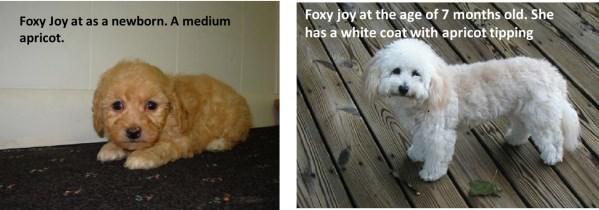
When a Dog Turns Gray
Due to the genes that are in Maltipoo dogs, the dog can have a gene called "G locus"....And this causes a graying of the coat as the dog grows. This does not happen due to being old, it is an early graying in which hairs are turning due to the instructions of the gene. If this is to occur, it most often starts to happen at the age of 2 to 3 months and there will be a gradual change-over until the age of 1 to 2 years.
Phantom
Coats can hold Phantom Markings (in accordance with the AKC who presently does not recognize the Maltipoo) which is the term for when a bi-colored dog (also referred to as a parti) has 2 or more colors that blend together in a specific way and in certain areas of the body. Phantom markings are when light colors appear against a darker coat. These markings will appear in certain areas:
- Above the eyes (referred to as the dog's eyebrows)
- The muzzle
- The throat
- The legs
- The feet
- Below the dog's tail
With this hybrid, phantom markings for black dogs are when black is combined with: apricot, brown, bronze, cream, gray, red or silver. With brown and red , phantom markings will apricot.


